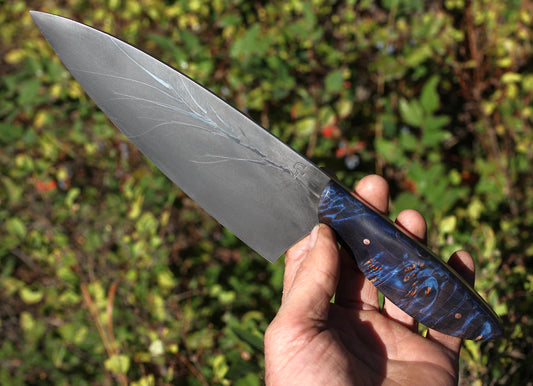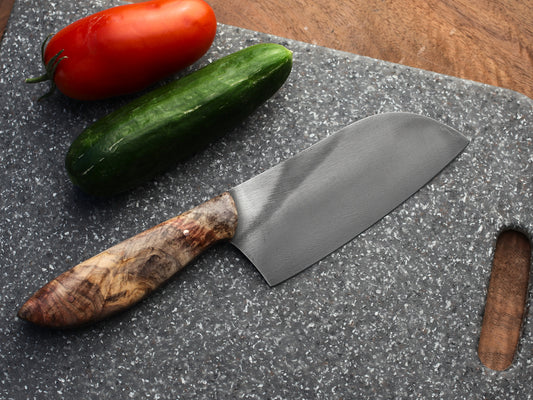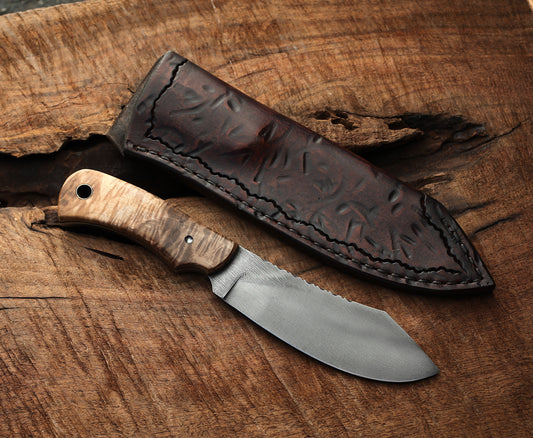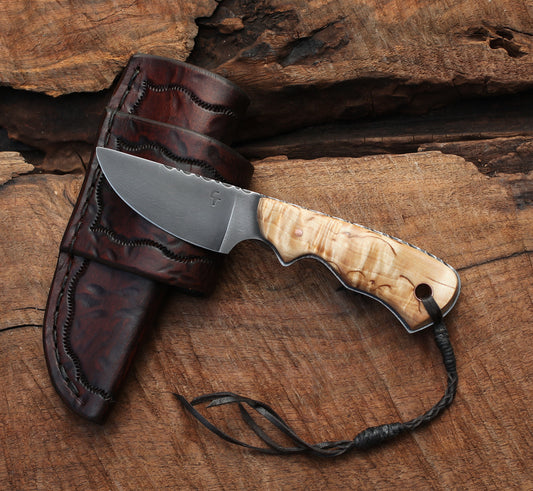Knife Sharpening and Maintenance
Sharpening is done by stropping. I grind the majority of my blades flat and finish on a soft platen or slack belt, resulting in a full convex edge. A convex edge is the most durable of edges and also, I think the easiest to sharpen, not requiring a special sharpening device.
Table Top Strop:
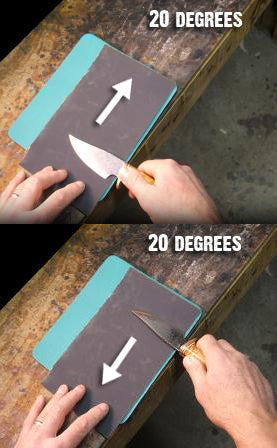
All that is required is a table top, a computer mouse pad and sheet of 500 or 600 grit wet/dry sandpaper. Have you seen the barber sharpening his razor on a length of leather strap? The technique is basically the same. Lay your sandpaper on top of the mouse pad next to the edge of the table. Lay the blade at approximately 20 degrees with the edge away form you. Now pull the blade to yourself with very little< down pressure to depress the edge slightly into the pad. Your leading with the top of the knife, opposite of how you would sharpen with a stone, Pulling instead of pushing. Then flip your blade and lead again with the top of the knife as you push away from yourself.
With a little practice you will actually feel and hear when you are at the right angle to form the edge. If you are too steep you’ll loose your edge and if not steep enough you’ll just scratch the sides of the blade and won’t form an edge.
When you have a decent edge and you want to make it shaving sharp use the same technique but instead of a mouse pad and sandpaper just use some heavy leather that has been sanded horizontally with a 60 grit belt. Make sure your leather is flat and not curling up on the ends. Maybe contact glue it to a board.
Strop your knife at a little steeper angle with a little more pressure.
From feedback from the hunters out there who have my knives, they have been processing at least one large animal, sometimes two. After stropping just a minute or two literately, you will be able to shave the hair on your arm, and your ready for another animal. Try it, you’ll like it.
Field Strop:
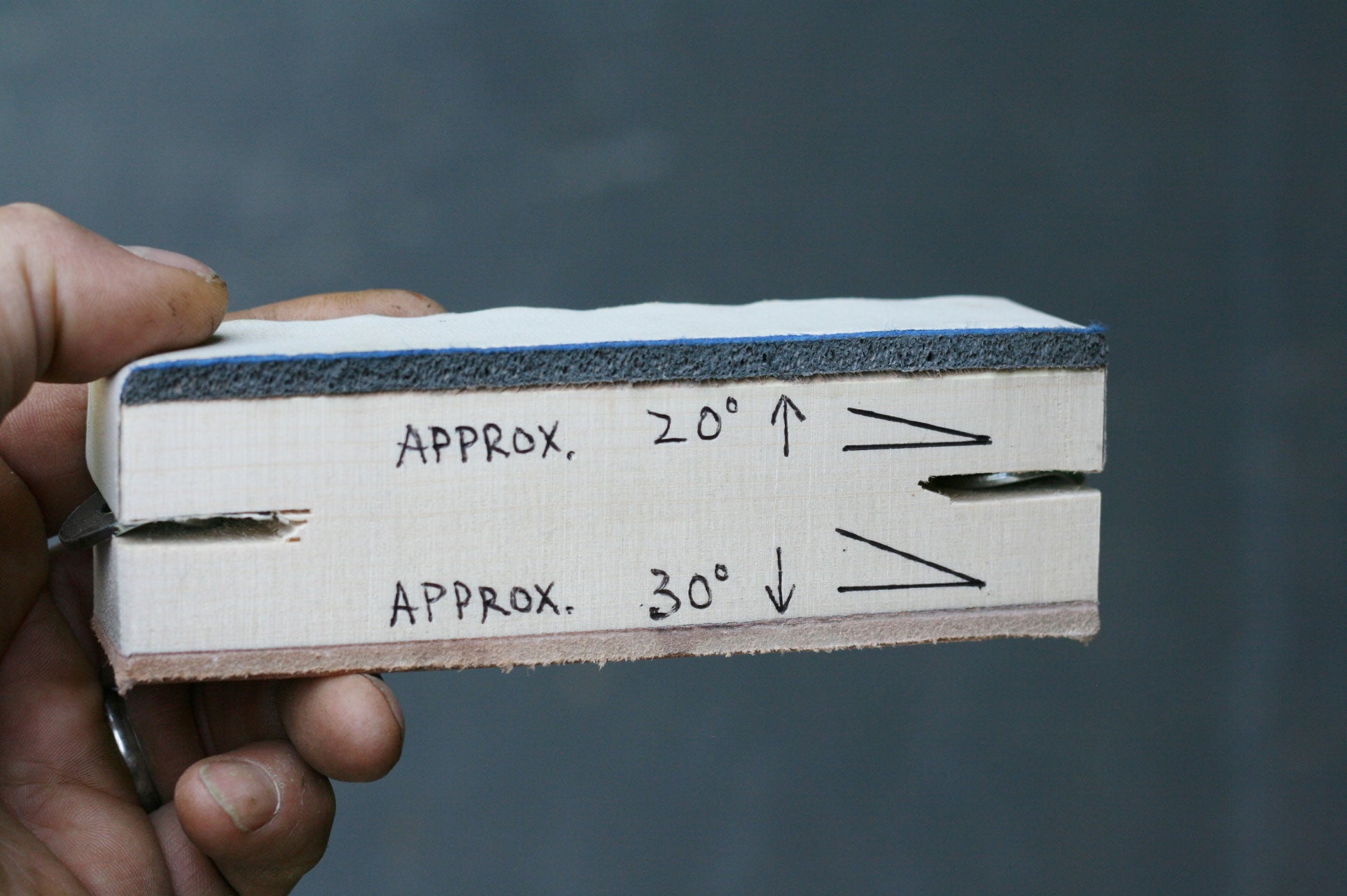
For a easy to use portable device, not my idea but it sure works well ! Use a 6 inch long piece of 2×2. Cut with a band or jig saw a 1..5 in. cut into each end of the 2×2. Now cut a piece of computer mouse pad to fit the top of the 2×2 [6in x 1 5/8in.] Glue it one side of the wood. Now cut your sandpaper [500-600g wet/dry] to fit the sanding block. A horizontal piece of a 8×11 sheet works perfect. Wedge a slightly bent washer between the paper and the cuts in either end of the 2×2. Glue a piece of heavy leather to the other side of the block. Sand the leather with a coarse belt (60grit) horizontally . I use my 6 x 48 sander.
Start with the sandpaper side, line your knife up with the 20 degree mark. With slight pressure strop once each side with new sandpaper, it may take 2 or 3 times with worn sandpaper. Then, flip the strop over and line your knife up with the 30 degree mark with a little more pressure because the leather does not "give" as much as the mouse pad . One or two passes per side should be sufficient, doing so will remove any wire edge you’ve made. You will find that the sanded leather will really finish the edge. Occasionally sand the leather on your strop so it continues to bite the steel.
Remember — included with a $200. or more knife purchase is a portable strop like the one pictured.
Knife Maintenance
After using the knife just rinse well with water and towel dry before storage. Simple carbon tool steels will rust if they are put up wet.
It is normal for a patina to develop on the blade because of oxidation, especially with acid foods like tomatoes. Just like our moms old kitchen knives that always worked well, the steel used in most of my knives is very similar and will turn darker with use. A bright finish can be maintained with a brass polish such as Flitz though it is not recommended with kitchen knives.
If a Damascus blade appears dull it can be lightly sanded with a worn 900-1200 grit belt to brighten. Using a small piece of wet/dry sandpaper (single layer) and light pressure, use one finger under running water or a little WD40. If you use water, after drying be sure to protect the steel with a protectant. A good Carnuba car wax works great.(i.e. Collinite, Mothers). Don’t use silicon based waxes.
Handles- Clean with water and mild soap. Protect with the same Carnuba based car wax. Carnuba works well on wood, antler or horn.
Sheaths- wipe with a damp cloth. Let dry and wipe down with Tandy’s Tan Cote if the sheath looks dull.
In really wet surroundings I like to use Snow Seal (bees wax) to protect from moisture. Letting the sheath dry for at least 24 hrs indoors is a good idea if you have been out in the rain. Of course remove the knife from the sheath when drying or putting into storage for months at a time.
Need your knife sharpened or the sheath cleaned up? You cover shipping in both directions and I’ll do it at no cost.
Available Knives
-
7.5 inch Chefs Knife, blue maple burl
Regular price $550.00 USDRegular priceUnit price / per -
5.75 inch Camp Chef knife, box elder burl
Regular price $450.00 USDRegular priceUnit price / per -
Nessmuk hunting knife, figured maple
Regular price $395.00 USDRegular priceUnit price / per -
Guardless Little Guy, masur birch
Regular price $495.00 USDRegular priceUnit price / per

